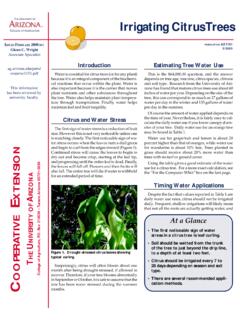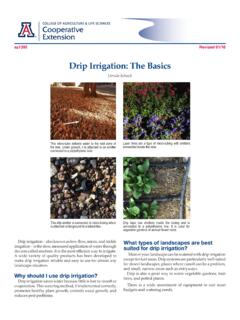Transcription of Problems and Pests of Agave, Aloe, Cactus and Yucca
1 ARIZONA COOPERATIVEE TENSIONP roblems and Pests of agave , Aloe, Cactus and YuccaAZ 1399 Revised 03/112 The University of Arizona Cooperative ExtensionTable of ContentsAbiotic (non-living) Problems ..3 selecting the correct plant and planting location ..3 Freeze Damage ..3 Sunburn ..3 Planting depth ..4 Poorly drained ..4 Hail damage ..4 Diseases ..4 Fungal diseases of pads and leaves ..4 Phyllosticta pad spot ..4 Anthracnose of agaves ..5 Other fungal lesions ..5 Fungal crown rot of Echinocereus ..5 Pythium rot of barrel cacti.
2 5 Root and crown rot of agaves ..6 Bacterial necrosis of saguaro ..6 Sammon s virus of Opuntia ..6 Insects ..6 agave Snout Weevil (Scyphophorus acupunctatus) ..7 Cactus longhorn beetle (Moneilema gigas) ..7 Cochineal scale (Dactylopius coccus) ..7 Plant bugs ..7 Coccid scale, soft scale ..8 Mites ..8 Animals ..8 For More Information ..9 3 The University of Arizona Cooperative Extensionpaired; but unless the freeze is of particularly long dura-tion or exceptionably cold, the damage may be only cosmetic, and the plant will grow out of it.
3 When exposed to a severe freeze, portions of columnar cacti will yellow, and then die completely (Fig. 2). In freeze-damaged barrel-type Cactus , the margins of ribs become straw yellow. If temperatures are not substantially below freezing (a hard freeze ) and the freeze lasts for only a few hours or less, only the epider-mis may be damaged, and the plant will outgrow the dam-age in several years. Yuccas may be damaged by sub-freezing temperatures. The damage will appear similar to that of the freeze damaged agave in Fig.
4 1. When the freeze is of long duration, extreme, or the species is not suited for the local cli-mate, damage may be damage can be prevented. It is important to become acquainted with temperature requirements of the particu-lar species. Protective measures often can be taken to assure survival. Cold-sensitive plants should be grown in areas that receive radiated heat at night from a patio or wall or in hilly areas where air temperatures are slightly warmer. Covering the plant with a cotton sheet will help on nights that are just at or slightly below freezing.
5 Another strategy is to place a 60-watt light bulb under the cotton sheet, taking care that the light bulb does not touch the plant or the cotton sheet. Do not cover the plant with plastic sheeting. Plastic is a poor insulator and will transfer the cold directly to the plant wherever it touches the plant. Containerized plants can be moved indoors until freezing weather has passed. If kept dry and placed in a brightly lighted area, they will survive without damage. Extremely low temperatures may cause a loss of turgor in saguaros.
6 This causes sagging of branches (arms) or death of the apical meristem (growing tip) that results in saguaros with many stems or heads .SunburnSunburn is a common problem in greenhouse or shade house grown plants. It is also problematic in plants grown in open beds or fil-tered sunlight in nurseries when these plants are trans-planted into open landscapes. Those parts of the plant that have not been acclimated to direct sun will burn plants turn yel-low. As the damage progresses, the epidermis turns straw yellow and dies.
7 Barrel cacti and columnar cacti are very Agaves, aloes, cacti and yuccas are classified as succulents - plants that have highly specialized anatomical features such as thick waxy cuticles, fleshy or minimal leaves, modified leaves (spines), and roots with extra storage capabilities for food and water. These modifications allow them to survive and thrive in harsh desert environments. They survive long periods of drought in areas of sparse rainfall and intense heat. During stressful periods many succulents cease to grow.
8 They drop unnecessary leaves, dehydrate and become dormant until conditions for growth return. Despite their adaptations succulents suffer from diseases, insect Pests and cultural Problems . Some of the more common Problems that occur in agave , aloes, cacti and yuccas in Ari-zona are discussed in this (non-living) problemsAbiotic Problems are not caused by living organisms. They include poorly drained soils, sun exposure, and weather events such as cold and high temperatures, excessive rainfall, over watering, planting too deeply and hail damage.
9 In trans-planted agaves, aloes, cacti and yuccas, abiotic Problems are probably the most common Problems that growers and hom-eowners encounter. selecting the correct plant and planting locationCareful selection of species that are suited to your local con-ditions is necessary and will eliminate or diminish serious Problems . Choose species that are found in your neighbor-hood or area. Visit specialty Cactus and succulent nurseries and discuss cold hardiness, heat and cold tolerance, mature size of the plant, growth rate and known Problems of a specific plant with the nursery personnel.
10 Contact your local Coopera-tive Extension office for expert advice. Visit local arboreta that have extensive succulent collections. Choosing the right plant for the right place is the first step in successfully growing these unique plants. Most succulent species originate in areas of diverse habitats. For example, many agaves grow in pine and oak forests, open grasslands and even in barren open areas. By researching a little about your plants and their special requirements, they can be planted in areas of your yard that fulfill most of their DamageMany of the more showy and exotic succulents originated in frost-free climates.

















